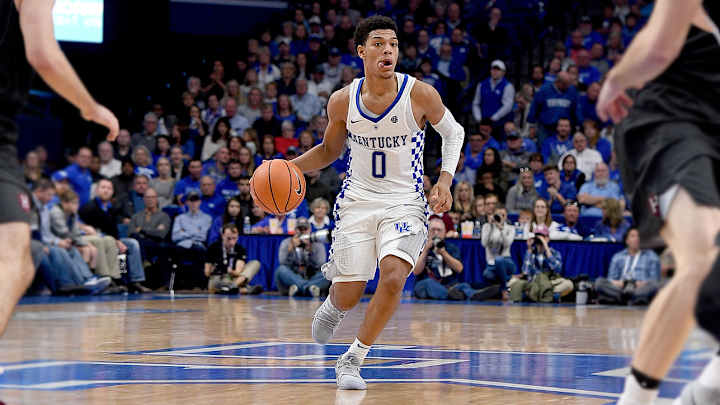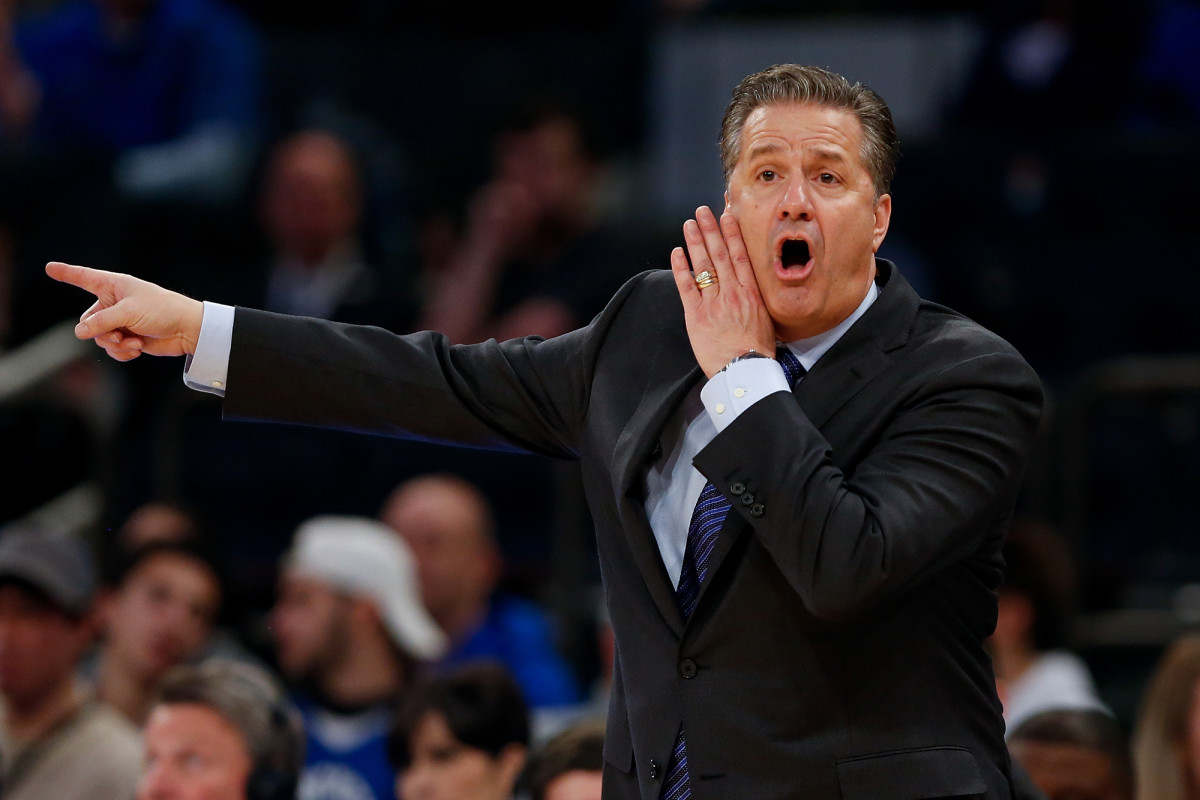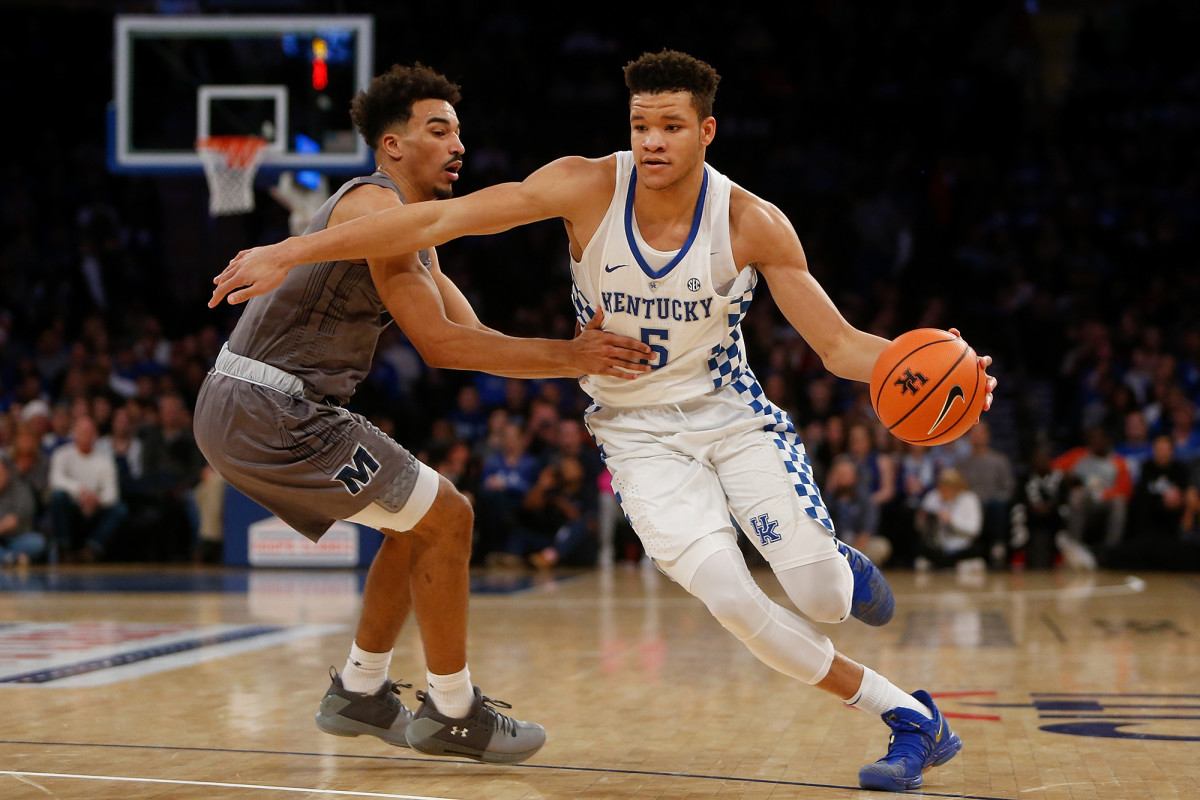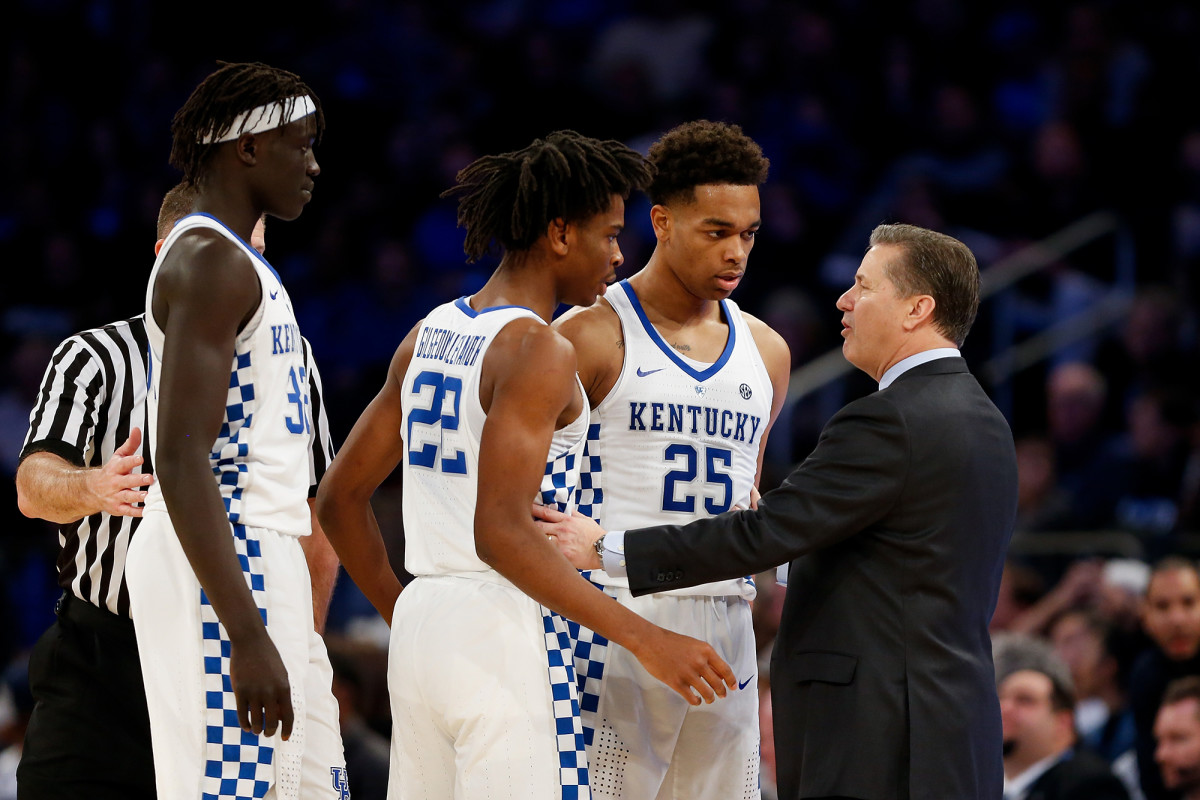Four Factors That Will Define Kentucky's Season Going Forward

NEW YORK — The first week of the season was the last time Kentucky played a game of major import. Since losing to Kansas by four points in the Champions Classic in Chicago on Nov. 14, the Wildcats have strung together six wins over low-level competition, the latest being a 93-76 triumph over Metro Atlantic Athletic Conference foe Monmouth on Saturday. Sports Illustrated was in attendance at Madison Square Garden as the Wildcats beat down the Hawks to improve to 8-1. Below is a quartet of takeaways on how one of college basketball’s biggest brands has fared through the first month of the season. This is the fourth version of a weekly column analyzing four college hoops topics bound by some underlying narrative thread. If there’s something you’d like to see in this space, don’t hesitate to reach out to me.
Kentucky’s lack of shooting could be a problem

At Kentucky’s preseason media day in October, Calipari downplayed concerns about his team’s shooting ability. “Well, our forte is not going to be, ‘well, that’s a shooting team,’” he said. “But how many of my teams have been that?” Calipari’s description was on-point, though he underplayed the extent to which the Wildcats would eschew the three. They aren’t just limiting their attempts from behind the arc. They seem to be taking them only as a last resort, and the cramped spacing that could create against well-drilled defensive squads is worrisome. Just 22.4% of Kentucky’s shots have come from distance, the lowest percentageamong Division I teams, and it’s making just 34.7% of those, good for 179th in the nation.
The Wildcats’ aversion to the long ball has a simple explanation: They don’t have many quality deep marksmen. Starting point guard Quade Green is the only Kentucky player who’s made more than a third of his tries from downtown on at least two attempts per game, and he’s put up only 20 of them so far. Freshman Jemarl Baker, a four-star guard out of Eleanor Roosevelt (Calif.) High, was regarded as the premier long-range shooter of the Wildcats’ recruiting class, but he’s been sidelined since undergoing knee surgery in late October and isn’t expected to be available until conference play. Knox has been Kentucky’s most frequent trifecta launcher by a considerable margin (4.8 per game), and his sound shooting mechanics offer hope that he could develop into a perimeter sniper, but he’s not there yet, having connected at a 32.6% clip this season. (Knox’s mid-range work has been shaky, too. He’s averaging only 0.5 points on looks between 17 feet and the three-point arc, according to data from Synergy Sports Technology, and he’s hovering just below 70% on his free throws.)
The Wildcats don’t need to completely revamp their shot allocation. They have multiple guys capable of getting into the lane off the dribble, they’re tough to guard in transition, they’ve done well to extend possessions by crashing the offensive glass (37.4 OR%) and they’re converting at a 70.6% clip around the rim, which ranked 22nd in the country as of Wednesday, according to hoop-math.com. That said, Calipari said recently that his team “should be able to make six threes a game, maybe seven,” and Saturday’s win was encouraging on that front: Kentucky went 7-of-19 from behind the line. It needs to keep it up. The Wildcats are now averaging 4.5 made triples per contest.
The importance of Kevin Knox

Kentucky was not expected to land Kevin Knox. After the five-star wing from Tampa Catholic (Fla.) High announced his college decision last May, spurning finalists Duke, Florida State, Missouri and North Carolina, 247Sports recruiting expert Evan Daniels tweeted, “I’m rarely shocked by a college commitment. I’m very surprised by Kevin Knox’s.” Though Knox may have been viewed as an unexpected, but welcome, recruiting victory at the time, the early part of this season has laid bare how important his addition was for Kentucky. Knox is the Wildcats’ leading scorer on a per-game basis (15.2 PPG), he’s their only viable long-distance shooting threat on the wing, and he could develop into one of their most formidable defenders thanks to his combination of length, agility and adaptability—whether Kentucky’s playing man or zone (which they’ve rolled out 14.4% of the time this season, per Synergy.) Knox had a rough day on Saturday, scoring only two points and committing a season-high seven turnovers in 31 minutes, but in his post-game news conference, Calipari put a positive spin on the performance. “It’s good for the soul to go 1-for-9,” Calipari said.
For the most part, though, Knox’s influence on Kentucky’s play has been undeniably positive. Over eight games leading into the Monmouth win, Kentucky scored 0.09 more and gave up 0.27 fewer points per possession with Knox on the floor, according to data from hooplens.com. It’s no wonder Calipari rarely gives him a break. Knox has played 86.9% of available minutes this season, according to Kenpom.com. There are only three players since Calipari showed up in Lexington in 2009 who’ve logged a higher percentage over the course of an entire season: Brandon Knight as freshman in 2010-11 (89.4%), Jamal Murray as a freshman in 2015-16 (87.1%) and Tyler Ulis as a sophomore in 2015-16 (88.5%). The return of freshman Jarred Vanderbilt from a foot injury will give Calipari another option on the wing—though Calipari said this week that Vanderbilt isn’t practicing with the team yet—and there are lineup permutations Calipari ought to try with redshirt freshman Hamidou Diallo at small forward. For the time being, however, it looks like Knox is going to keep shouldering an atypically big playing-time load, which Calipari described recently as “too many” minutes. Maybe Knox can handle it just fine, but either way, the fact Calipari is so reluctant to put him on the bench attests to his value in the Wildcats’ rotation.
Kentucky could be terrifying on defense
The trait that defines the Wildcats’ loaded 2017 recruiting class is its length. The five-star-stuffed haul includes five players with wingspans measured at 7-foot or longer: Shai Gilgeous-Alexander, Knox, Nick Richards, P.J. Washington and Vanderbilt. Diallo, who enrolled at Kentucky in January but didn’t play last season, and sophomore power forward Sacha Killeya-Jones also clear that bar. Green, a 6'0" freshman from Philadelphia, is the only rotation player whose wingspan is shorter than 6'11". With so many pterodactyl-proportioned athletes roaming the court, the Wildcats can obstruct passing lanes, blanket ball handlers on the perimeter, cover ground quickly to contest shots and deter drives to the rim.
Getting buckets inside the three-point line on Kentucky will be a chore all season—as Monmouth learned on Saturday, when it shot just 16-of-41 on its twos while contending with the Wildcats’ smothering coverage—but Kentucky needs to do a better job running teams off the arc. 43% of opponents’ attempts have come from deep, which is the 42nd-most in Division I. (Fortunately for the Wildcats, those have gone in only 30.2% of the time.) That deficiency noted, Kentucky has proved it can keep an elite offense in check. At the Champions Classic, it held the Jayhawks to only 0.93 points per possession, and it has rejected 18.2% of opponents’ two-point attempts so far, good for eighth in the country.
This team won’t approach the squad led by Karl Anthony-Towns and Willie Cauley-Stein in 2014-15 that reached the Final Four undefeated and yielded only an adjusted 0.84 PPP, according to Kenpom.com, but its physical attributes will overwhelm most SEC teams, even if it could take some time before such an inexperienced group is consistently executing at a high level. (In case you were wondering, the Wildcats don’t face Alabama supernova Collin Sexton until the middle of February, in Rupp Arena.) The point is that the potential exists, given Kentucky’s personnel and head coach John Calipari’s track record with young squads, for it to grow into a defensive monster. Whether Calipari will get this one there isn’t totally clear yet.
This team needs time

Like the Kentucky teams that preceded it during Calipari’s tenure, this team is young. But these Wildcats are notable for how little they brought back from the previous season, and consequently how much they’ll be relying on new blood. Kentucky lost every rotation player from 2016-17 save sophomore forward Wenyen Gabriel, and it returned only 11% of its minutes, tied for the second lowest mark in the country. (Only Pittsburgh is lower, at 9%.) Don’t feel bad for the Wildcats: Unlike most programs trying to weather personnel attrition, they replenished their roster with eight (Diallo included) of the most coveted high school players in the country. But for Calipari, compiling a recruiting class brimming with top-end talent is just the beginning of his process to build Final Four teams. Those prospects need to be molded into cohesive units with defined roles that can be trusted to go hard on both ends of the floor for 40 minutes and not wilt in pressure-packed environments. This team—which, again, has faced only one opponent of note, and acquitted itself well against that opponent—is not there yet, but it doesn’t need to be. “We’re just getting going,” Calipari said on Saturday. He added, “We’re trending the right way.”
This version of the Wildcats should be granted more patience, with more restraint on midseason alarm-sounding, than usual. For one, when Vanderbilt is fully recovered, he’ll give Kentucky another long, mobile forward who can make plays in transition and help out on the boards. For another, Calipari has earned the benefit of the doubt with his NCAA tournament CV (six Elite Eights and four Final Fours in the last eight seasons). He’s shown he can gets his guys up for the tourney even when they’ve limped to the finish line in SEC play. You’ll recall it was only four seasons ago that Kentucky entered the NCAAs as a No. 8 seed after a disappointing regular season in which it opened as the No. 1 team in the AP Top 25 largely on the strength of its top recruiting class. That outfit reached the title game.
